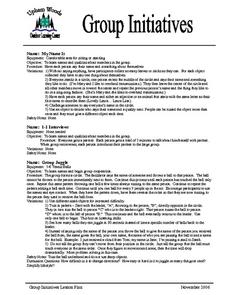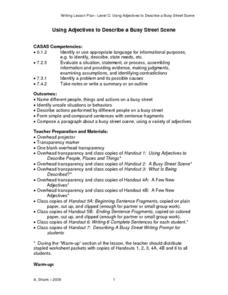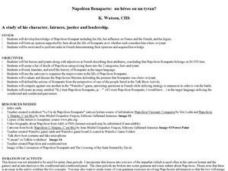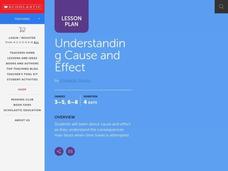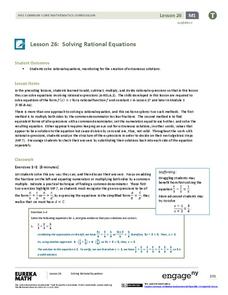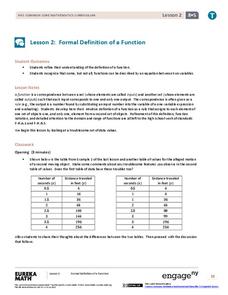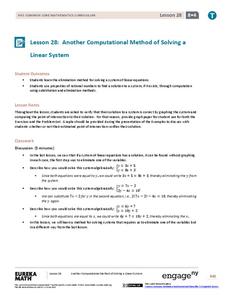Curated OER
Vocational: Basic Sewing
Learners discover how to use sewing machines, ironing boards, and steam irons. Using diagrams, they label all the parts of a sewing machine and solve crossword puzzles in groups. Following a teacher demonstration, students sew their...
Curated OER
Graphing System of Equations
Students solve system of equation. In this algebra lesson, students graph, substitute and eliminate to solve system of equation. They identify the point of intersection and how many solution each system will have.
Curated OER
Busted!
Students play a math game using teacher-created cards that target a specific math skill. They solve the presented equations and check their answers with one another. If they are correct they keep a card, if not the card is discarded.
Curated OER
Fat - A Concentrated Energy Source
High schoolers study fats as a necessary part of a balanced diet. They match foods with visuals showing the amount of fats in each. They compare lunches and how substitutions of various foods can effect the fat content of each meal.
Curated OER
Puzzle Prints
Students explore the basic techniques of printmaking in this introductory lesson for the elementary Art classroom. Included with this lesson are ideas for successful implementation and step-by-step directions for the teacher with no...
Curated OER
The Wonderful World of Polymers
Seventh graders investigate the concept of polymers. They discover unique properties and how polymers are natural. The lesson contains sufficient background information for the teacher. Students examine different types of materials and...
Curated OER
Summarization Mapping
Students observe and demonstrate the strategy of summarizing the main idea. They discuss six rules of summarizing, and observe the teacher summarizing the first chapter of the novel "The Incredible Journey." Students then read chapter...
Curated OER
Water Contamination Demonstration
Learners discuss water pollution and the Safe Drinking Water Act of 1974 after watching a teacher demonstration in which different contaminants are added to tap water. While some contaminants are not harmful to the body, in excess they...
Curated OER
Group Initiatives
Students explore the names and qualities about members in the group. They each say their name and something about themselves. Students gather around in a circle. They listen to the teacher as he or she says the name of someone and throws...
Utah State Courts
Judges in the Classroom
Class members explore the process of a disposition hearing for juveniles, particularly looking at how the judge decides what sentence the juvenile offender should receive. Task your pupils with evaluating different sample cases provided...
Saint Paul Public Schools
Using Adjectives to Describe a Busy Street Scene
What just happened in the street? After several introductory activities about adjectives and description, pupils use all that they have learned to compose a paragraph about a hectic intersection.
Curated OER
How to Organize a Lesson Plan
Students fill out a lesson plan, just like their teacher. In this how to lesson, students discover the components needed in a lesson plan. Students plan a lesson and share it with the class.
Curated OER
How Big Is That Star?
Aspiring astronomers study stars. They compare stars and explain the relationship between radius, mass, and diameter. By creating a star simulation, they discover how a binary star system's orbit can cause changes in the observed...
Curated OER
Pie Crust Experiment
This experiment can be used as a pre-assessment to see what experience and knowledge the high schoolers have in preparing pies. They identify the difference in taste, flavor, texture and appearance as they substitute different...
Curated OER
Language Arts: Inclusion and Writing Skills
Students, in special education and inclusion classes, practice writing skills by sharing notes with the teacher and each other. Using instruction sheets, they substitute words and rewrite the selection in a way they understand. In...
Curated OER
Water Pollution
Fifth graders examine what contaminated water looks like, and how it becomes polluted. They examine a teacher demonstration of water is not polluted but does contain rocks and other things that do need to be cleaned out before drinking...
Curated OER
"Sum, Sum, Sum It Up!"
Learners are provided with a model of how to better comprehend text through using a summarization rubric which includes: deleting trivial information, deleting repeated information, substituting easy words for lists of items, adding a...
Curated OER
Treated Lumber and Alternatives
Students copy the KWL chart for Treated Lumber and Alternatives. They include the provided websites. Students work with a partner to research the use of CCA lumber and its environmentally friendly substitutes. They create a PowerPoint...
EngageNY
Find Solutions to Make Equations True
The truth is always best. Individuals continue to find values that make equations true in the 26th installment of the 36-part module. The only difference is that they now call them solutions to those equations.
Curated OER
Napoléon Bonaparte: un héros ou un tyran?
Was Napoléon Bonaparte a hero or a tyrant? Discuss examples of each, and list their common attributes. Then, to form a solid argument and take a stance, intermediate and advanced Francophones conduct Internet research. After a few days...
Curated OER
Understanding Cause and Effect
Young scholars experience and study cause and effect as they assess the consequences man faces when time travel is attempted. They determine, in their imaginations, what time period they would like to visit. Each student then listens to,...
EngageNY
Solving Rational Equations
What do fractions and rational expressions have in common? Everything! Learners use common denominators to solve rational equations. Problems advance from simple to more complex, allowing pupils to fully understand the material before...
EngageNY
Formal Definition of a Function
Formalize the notion of a function. Scholars continue their exploration of functions in the second lesson of the module. They consider functions as input-output machines and develop function rules for selected functions.
EngageNY
Another Computational Model of Solving a Linear System
The process of elimination really works! Use elimination when substitution isn't doing the job. The 29th segment in a series of 33 introduces the elimination method to solving linear systems. Pupils work several exercises to grasp the...








